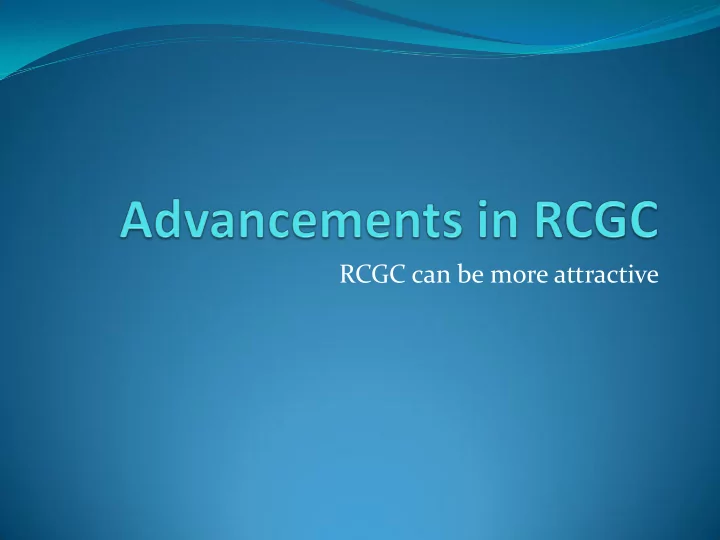

RCGC can be more attractive
Advantages of RCGC simple to implement Identify garbage as object dies Immediate reuse of storage Good spatial locality of reference Only objects in pointer reference need to be accessed Does not require additional heap storage to prevent GC from croaking Time overhead distributed throughout computation 2
Advantages of RCGC Adopted in several systems Unix utilities awk and perl, Unix file systems, Memory managemet in distributed systems Reduced communication overhead due to good locality of reference 3
Deficiencies of RCGC Cost of removing last pointer unbounded Total overhead of adjusting RCs significantly greater than that of tracing collectors Substantial space overhead Inability to reclaim cyclic data structures 4
How do we overcome shortcomings? Problem Cost of removing last pointer unbounded Depends on size of sub-graph rooted at garbage object Solution Non-recursive freeing Weizenbaum : when last pointer to objet Q is deleted, simply push Q unto free-stack Use free-list as a stack RC field used to chain stack Lazy deletion (update() unchanged) 5
Reference counting example Root set Heap space 1 1 2 1 1 1 1 2 1 6
Reference counting example Root set Heap space 1 1 2 1 0 1 1 2 1 7
Reference counting example Root set Heap space 1 1 2 1 0 1 1 1 0 8
Reference counting example Root set Heap space 1 1 2 1 1 1 1 9
Weizenbaum’s Algorithm new() { delete(N){ if freeList == NULL if RC(N) == 1 abort “Memory exhausted” free(N) newcell = allocate() // pop stack else decrementRC(N) for N in Children(newcell) } delete(*N) RC(newcell) = 1 free(N){ return newcell RC(N) = freeList // RC replace next } freeList = N } // push n unto the stack 10
Updating pointers update(R, S){ incrementRC(S) delete(*R) *R = S } 11
Effects of Weizenbaum’s Algorithm Less vulnerable to delays caused by cascading deletion If array is freed, all its pointers must still be deleted before its storage can be reused May/not be noticeable Loses some benefits of immediacy Memory inaccessible until data structure popped from stack See new() 12
How do we overcome shortcomings? Problem Total overhead of adjusting RCs significantly greater than that of tracing collectors Overhead of maintain RC high on conventional hardware Fetching counts may invalidate cache lines Pages containing remote data may be paged in ~ dozen instructions to adjust RC in both old & new pointees What about iterating over a list? Solution Deferred reference counting Allow as few RC updates as possible Deutsch-Bobrow Algorithm 13
Deutsch-Bobrow Algorithm Observation Majority of pointer writes are made in local variables Frequency of other pointer stores may be as low as 1% True with modern optimizing compilers Deferred RC takes advantage of observation Don’t count references from local variables or stack Use simple assignment Only count references from heap objects 14
Implications of Deutsch-Bobrow Object no longer reclaimed as soon as it RC drops to 0 What about references from stack? Objects with zero RC added to zero-count-table (ZCT) by delete() Periodically ZCT is reconciled To remove and collect garbage Note: possible for other heap objects to store references to entries in ZCT Increment RC of entry Remove entry from ZCT 15
Deutsch-Bobrow Algorithm delete(N) { /* Three phase reconciliation */ decrementRC(N) reconcile(){ if RC(N) == 0 for P in stack // mark the stack add N to ZCT incrementRC(*P) } for N in ZCT // reclaim garbage if RC(N) == 0 update(R, S){ for M in children(N) incrementRC(S) delete(*M) delete(*R) free(N) remove S from ZCT for P in stack S // unmark the stack *R = S decrementRC(*P) } } 16
Advantages of deferred RC Very effective at reducing cost of pointer writes Experience with Smalltalk implementation on Xerox Dorado in mid-eighties Cut the cost of pointer manipulation by 80 % Add small space overhead Immediate vs deferred RC. [Ungar, 1984] Immediate Deferred Updates 15 3 Reconciliation 3 Recursive freeing 5 5 Total 20 11 17
Disadvantages of deferred RC Space overhead for ZCT ZCT can overflow Reduces RC advantage of immediacy 18
How do we overcome shortcomings? Problem Substantial space overhead Requires space in each object to store RC Worst case: field large enough to hold total # of pointers In heap and root set Solution In practice objects don’t have that many references Typically each object receives just a few references at a time Save space by using smaller RC field Limited-field reference counting 19
Sticky reference counts The RC of an object cannot be allowed to exceed its maximum possible value Its sticky RC Once a RC reaches this value, it is stuck It cannot be reduced since its true RC can be greater than its sticky RC It cannot be increased since it is limited by the size of the RC field 20
Adjusting sticky reference counts incrementRC(N) { decrementRC(N){ if RC(N) < sticky if RC(N) < sticky RC(N) = RC(N) + 1 RC(N) = RC(N) – 1 } } 21
Restoring reference counts Why is this necessary? An object cannot be reclaimed by RCGC once its RC reaches sticky RC needs to be restored Can use tracing collector Can collect cycles 22
Tracing collection restores RC mark_sweep () { mark(N){ for N in Heap incrementRC(N) RC(N) = 0 if RC(N) == 1 for R in Roots for M in children(N) mark(*R) mark(*M) sweep() } if free_pool is empty abort “Memory exhausted” } 23
Other RC Optimizations One-bit reference counting Unique pointer vs shared pointer Using an ‘Ought to be two’ cache A version of the one-bit RC Hardware reference counting With other optimizations RC still more costly than tracing collectors Need specialize hardware Self-managing heap memory based on RC Have not been successful commercially 24
Recommend
More recommend